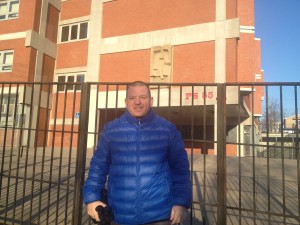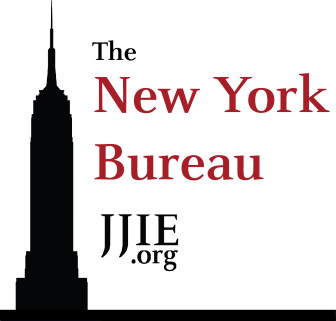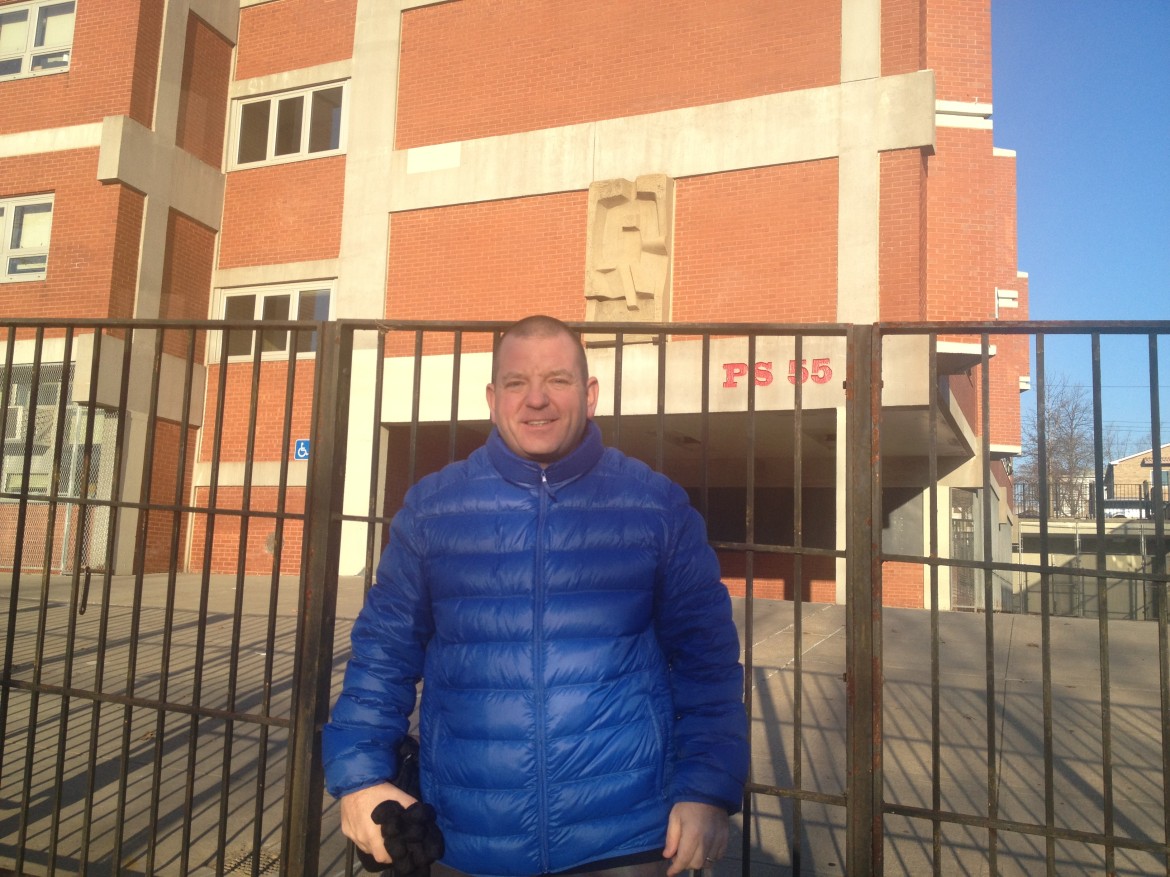
Michael Reilly, a former member of the NYPD who drafted a controversial school safety plan, greets students outside P.S 55 The Henry Boehm School in the south shore of Staten Island on a recent Tuesday morning.
NEW YORK -- It’s a frigid morning on Staten Island’s South Shore, with the temperature struggling to crack 20 degrees as a stiff wind buffets the Eltingville neighborhood. The elementary school students showing up at P.S. 55 are cocooned in puffy jackets, gloves and hats as they jump out of warm cars and onto the sidewalk towing large backpacks, some adorned with the face of Justin Bieber, others with the logo of the New York Giants.
Amidst an ongoing school bus strike, it’s a fairly orderly scene on this Tuesday. Parents drive up to the curb, let their children out and move on to the rest of the day. Directing traffic, and gently scolding the occasional parent who pulls a U-turn on Koch Boulevard, is Mike Reilly, a former New York City police lieutenant who is a few days shy of his 40th birthday.

Reilly is outside the school each morning mostly to mitigate traffic. But, as the co-author of a controversial school safety plan that calls for the Department of Education to use retired cops armed with guns to protect city schools, he’s also found himself in the middle of the contentious debate over gun control and student safety that has erupted in the wake of the December massacre at Sandy Hook Elementary School. At a White House ceremony last week, President Barack Obama, speaking in front of an audience that included children who had written letters to the president asking him to take action against gun violence, introduced a broad set of gun control measures and policy initiatives to make schools safer and crack down on mass shootings. The National Rifle Association, meanwhile, has vowed to fight any effort to regulate firearms.
Reilly, who has two daughters at P.S. 55 and a son who went there but has since graduated to middle school, started volunteering at the school in 2007, after he retired from the NYPD because of an injury he suffered chasing a stolen motorcycle in Brooklyn.
Reilly has since joined Community Education Council 31, which covers all of Staten Island. He co-chairs the Safety and Transportation Committee with Frank Squicciarini, a 48-year-old retired NYPD sergeant. In the aftermath of Sandy Hook, the two former cops have immersed themselves in the issue of school safety in New York.
Reilly and Squicciarini are the authors of a school safety plan that passed CEC 31 earlier this month and calls for the city to hire up to 500 retired police officers to serve as armed guards in schools. The retired officer would dress in plain clothes and carry concealed weapons.
The proposal, billed by CEC 31 as a comprehensive safety plan, also includes the installation of silent alarms, which would be linked to 911, and “buzzer entry systems,” with video cameras, at schools around New York. So far, most of the attention has focused on the armed guards, with critics linking the plan to one proposed by the NRA about a week after the shooting in Newtown.
Even before it passed, Mayor Michael Bloomberg, a staunch gun control advocate, called the CEC 31 proposal a “terrible idea.” He had previously ripped the NRA’s proposal to put armed guards in all schools across the country as “dystopian.”
But with President Obama pledging to make federal money available to improve school safety across the country, members of CEC 31 say Bloomberg and Schools Chancellor Dennis Walcott should at least consider using retired cops to guard city schools.
“This isn’t coming from some lobby group,” Reilly said. “We’re trying to do the best we can to protect our kids and our teachers and our administrators. That’s all this is about. These things are going to happen, all we can do is put in best practices to mitigate them.”
Sam Pirozzollo, the president of CEC 31, said some parents were opposed to “armed guards” in schools, until they learned that the plan called for retired law enforcement. “I don’t think what we’re asking for is that radical,” said Pirozzollo, 48, who has two kids in city schools. “It’s not about the NRA. It’s about the kids of Staten Island.”
Squicciarini and Reilly liken their proposal to the federal air marshal program, which puts armed officers in plain clothes on certain flights. Their existence is believed to create a deterrent for would-be hijackers. Squicciarini and Reilly both said, ideally, they would like an armed security officer in each of the city’s more than 1,000 school buildings. But they argued that the existence up to 500-armed officers rotating through the schools would create a deterrent for someone considering an attack.
“Most people attack what are called soft targets, where they know there will be little or no resistance,” said Squicciarini, who spent 24 years with the NYPD and joined the counter-terrorism unit after the attacks of 9/11. “With this, the thought of someone being there, you may have taken away that soft target.”
Reilly and Squicciarini think it’s unfair to tie their proposal to the NRA. They believe they’ve staked out a more moderate position, with key differences between what they’re proposing and the plan pushed by the gun lobby. For one, the retired cops potentially hired by the city would come to the job with at least 20 years of firearms training and a background in law enforcement. And with their concealed weapons and business casual dress code, the security officers would have a somewhat lighter footprint than a traditional uniformed police officer, or armed guard, they said.
“Kids shouldn’t see a gun visible every day walking in an out of school,” Squicciarini said.
Reilly agreed.
“We don’t want this to look like a police state,” Reilly said. “It’s not a security guard, with the uniform on and the sling and the holster. We’re talking about trained professionals with experience in law enforcement.”
In criticizing the NRA’s plan to put armed guards in schools, and by extension the CEC 31 proposal, both Bloomberg and Walcott have argued that New York’s schools are safe. Unarmed school safety agents are present in the city’s school buildings and a DOE spokesman said the department’s close working relationship with the NYPD has led to a drastic reduction in school crime over the last 12 years. Major crime is down 48 percent since the 2000-2001 school year, with violent crime dropping 30 percent in the same time period, DOE said.
Reilly, Pizorrollo and Squicciarini are not swayed by the crime statistics cited by DOE. They understand that schools have gotten safer, by some measures, but worry about the schools’ exposure to the type of tragedy that unfolded in Newtown. They pointed to the terrorist attack of Sept. 11, and the city’s effort to retool security protocols in its aftermath. They have not seen a similar change in school policy, despite a string of mass shootings around the country in recent years.
“Crime is the lowest it’s been, I understand that,” Reilly said. “This isn’t about crime. This is about preventing an active shooter.”
This story was produced by JJIE's New York City Bureau.
Photo by Craig Giammona.
